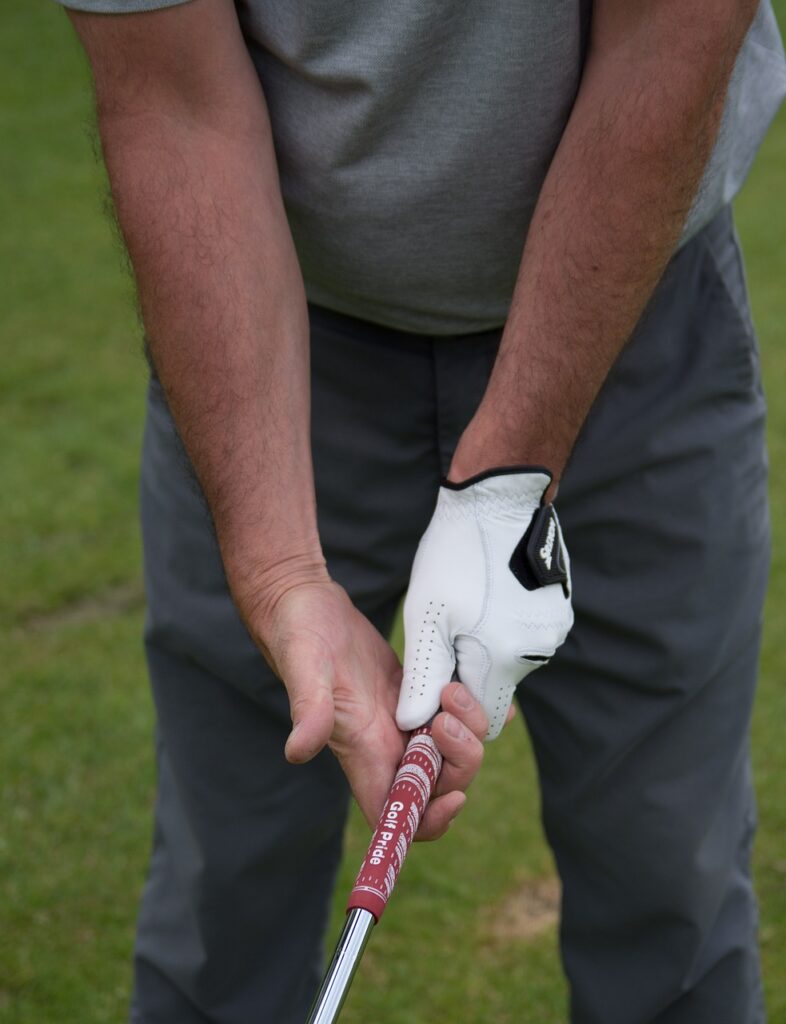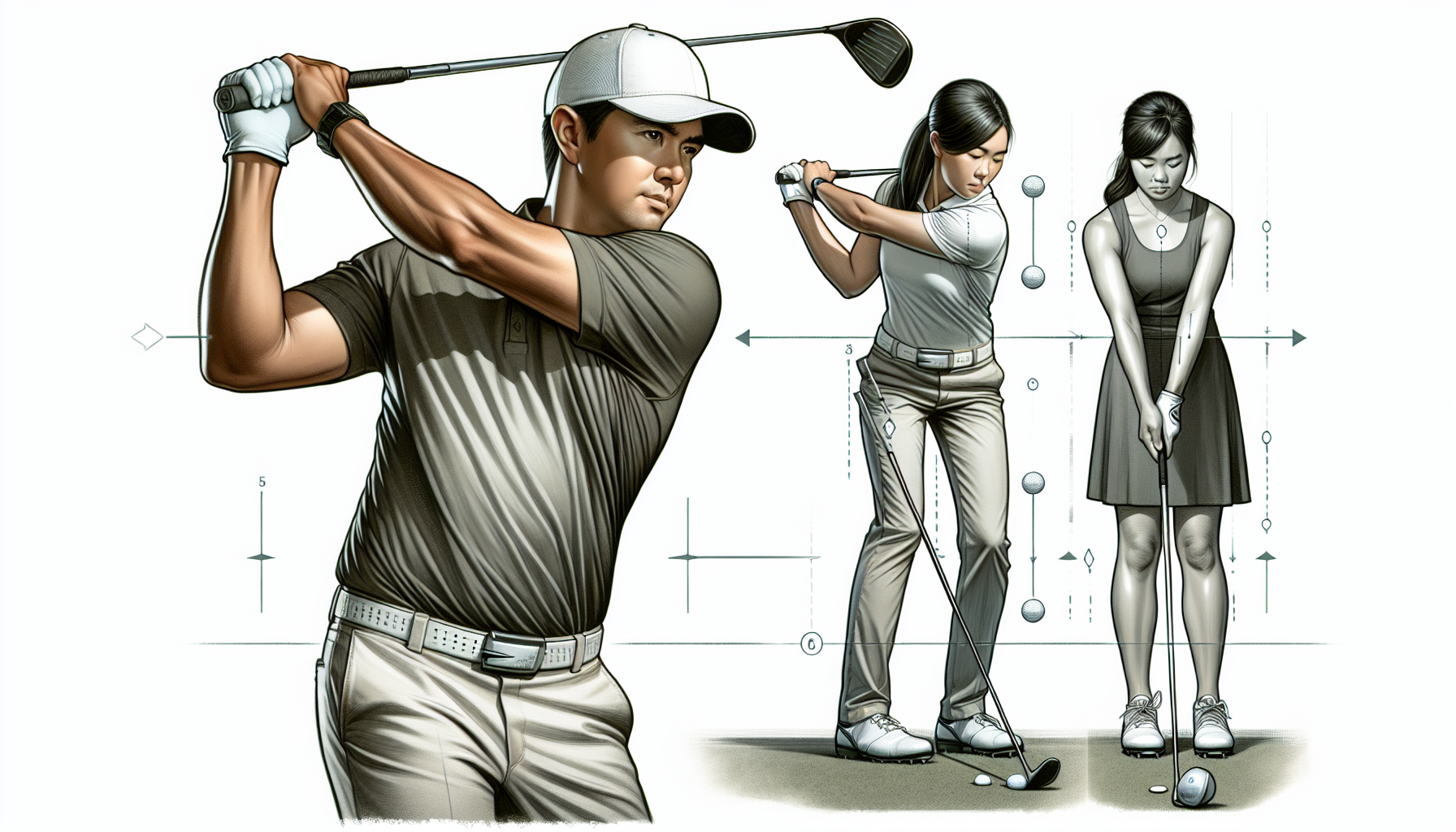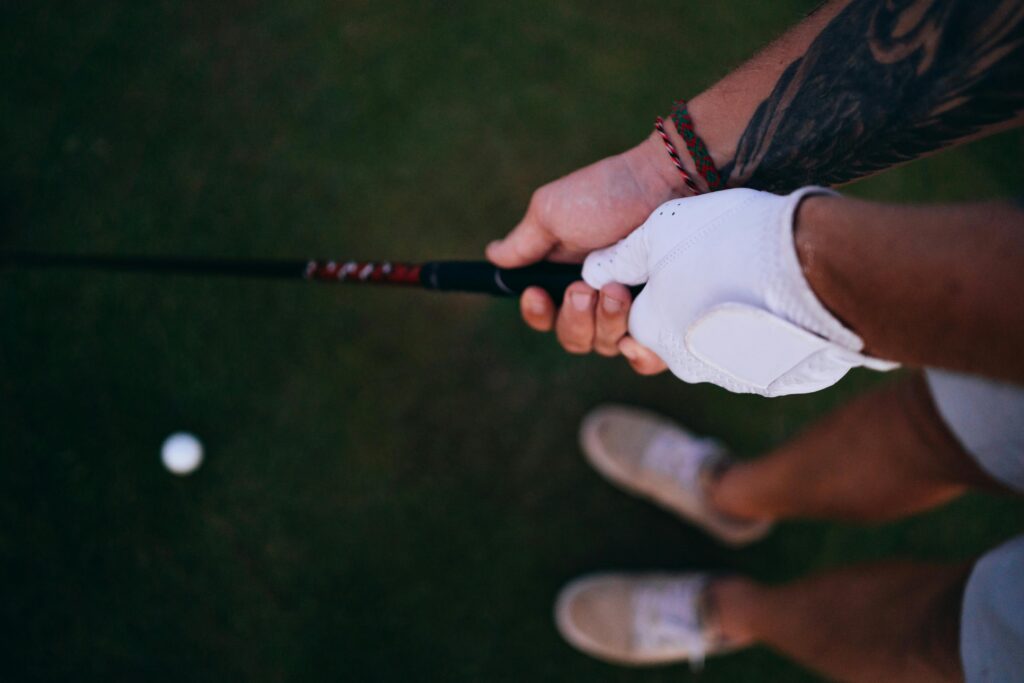Gripping a golf club correctly is crucial for control and consistency in your swing. The three main grip types are the interlocking grip, overlapping grip, and ten-finger grip. Proper hand positioning, grip pressure, and using golf gloves can enhance your grip security. Customize your grip for different clubs and shots, and regularly practice to maintain a consistent grip. For a detailed guide, including visuals and advanced techniques
Gripping a golf club correctly is fundamental to achieving control and consistency in your swing. This guide will provide step-by-step instructions on different grip techniques, essential tips, and how to customize your grip to improve your game. As a seasoned golf enthusiast with years of experience, I’ve honed my skills and learned from top professionals. This guide is crafted to help both beginners and advanced players refine their grip technique.
| Grip Type | Best for | Advantages | Disadvantages |
| The Ten Finger Grip | Power | Easy for beginners Feels natural Greater impact power | Hands can operate independently which can cause a power imbalanceToo much freedom in the wrists |
| The Overlapping Grip (Vardon grip) | Power and control | Perfect combination of freedom and control Great for larger hands Easier to follow the professionals | Can be awkward for smaller hands |
| The Interlocking Grip | Control | Locks the hands and wrists together, greater control but less power Reduces tension on the club Suits smaller hands | Awkward grip type for large hands Considerably reduces wrist movement, minimising power Forces reliance on whole body for power and accuracy May feel unnatural to begin with |
Types of Grips
Interlocking Grip: Common among players with smaller hands, this grip involves interlocking the pinky finger of your trailing hand with the index finger of your lead hand. This grip offers a secure connection between the hands, promoting unity in the swing. This grip can be seen frequently among professionals like Tiger Woods and Jack Nicklaus, highlighting its effectiveness.
Step by step
- Place your lead hand on the club with the thumb pointing down.
- Interlock the pinky finger of your trailing hand with the index finger of your lead hand.
- Ensure both hands work together seamlessly during the swing.
Overlapping Grip (Vardon Grip): Popular among professionals, this grip has the pinky finger of the trailing hand resting on top of the gap between the index and middle fingers of the lead hand. The overlapping grip is favored for its balance between control and power. Players like Ben Hogan and Phil Mickelson have used this grip to great success.
Step by step
- Position your lead hand on the club, thumb pointing down.
- Overlap the pinky finger of your trailing hand on top of the gap between the index and middle fingers of your lead hand.
- Focus on creating a unified grip for better control.
Ten-Finger Grip: Ideal for beginners or players with weaker hands, this grip has all fingers on both hands directly holding the club, similar to a baseball grip. It can provide a sense of control and comfort, especially for those new to the game. Many young players or those with smaller hands start with this grip before transitioning to one of the others.
Step by step
- Grip the club with all fingers of both hands directly on the handle.
- Ensure a secure yet comfortable hold, similar to holding a baseball bat.
- This grip can be particularly beneficial for those with weaker hands.
Grip Fundamentals
Hand Positioning: Place your lead hand first, ensuring the club rests diagonally across your palm. Close your hand around the club, then place your trailing hand below the lead hand, wrapping your fingers around the handle. Proper hand positioning is crucial for maintaining control and accuracy. Make sure your lead thumb points down the shaft, and your trailing hand’s lifeline covers your lead thumb.
Grip Pressure: Maintain a firm yet relaxed grip. Excessive pressure can hinder your swing, while too light a grip can lead to club slippage. Aim for a medium grip pressure, where the club feels secure but your wrists remain flexible. A good way to check your grip pressure is to hold the club and wiggle it; if it moves too much, you might need a firmer grip, but if your forearms feel tense, loosen your grip slightly.
Use of Golf Gloves: Wearing gloves can enhance grip security and comfort, especially in humid or rainy conditions. Gloves provide a consistent texture, improving your ability to hold the club steadily. Many golfers prefer a glove on their lead hand only, while some use gloves on both hands for added security.

Tips for Right and Left-Handed Golfers
- Right-Handed Golfers: Ensure your left thumb rests slightly to the right side of the grip, while your right hand covers the left thumb. This positioning helps promote a square clubface at impact. Check that the V-shape created by your thumb and forefinger points towards your right shoulder.
- Left-Handed Golfers: Place your right thumb slightly to the left side of the grip, with your left hand covering the right thumb. This setup mirrors the right-handed grip, ensuring consistency in the swing mechanics. The V-shape formed by your thumb and forefinger should point towards your left shoulder.
Customizing Your Grip

Different Clubs: Adjust your grip slightly depending on the club you’re using. For drivers, a lighter grip can increase distance, while for irons, a firmer grip can enhance control. Each club type may require a subtle variation in grip to optimize performance. For example, you might choke down on the grip for shorter shots to improve control.
Adjusting Grip Techniques: Experiment with minor adjustments in your grip to find what feels most comfortable and effective for you. Personal preference and hand size can influence the ideal grip style, so don’t hesitate to make changes. Some golfers find success with a stronger grip (rotating hands more to the right for right-handed golfers) or a weaker grip (rotating hands more to the left).
Visual Aids
Including high-quality images or videos demonstrating each grip type and technique can significantly enhance understanding. Visuals help illustrate the correct hand positioning and grip pressure. For example, images showing the interlocking, overlapping, and ten-finger grips in action can provide clear visual guidance.

Advanced Tips and Techniques
Neutral vs. Strong vs. Weak Grip: Understanding the difference between a neutral, strong, and weak grip can help you tailor your grip to your swing style. A neutral grip is balanced, a strong grip promotes a draw, and a weak grip can help with a fade. Experiment with these variations to see what suits your game best. For instance, rotating both hands slightly to the right (strong grip) can help close the clubface and reduce slicing.
Grip Adjustments for Different Shots: For finesse shots, such as chipping or putting, you may want a softer grip to enhance feel and control. For full swings, a consistent grip pressure that allows for a powerful release is key. For example, when putting, a lighter grip can help you feel the putter head more accurately, leading to better distance control.
Impact of Grip on Swing Path: Your grip can influence your swing path and clubface angle at impact. A strong grip can help close the clubface, reducing a slice, while a weak grip can open the clubface, helping to avoid a hook. Understanding this relationship can help you diagnose and fix swing issues. For instance, if you’re consistently slicing the ball, check if your grip is too weak and adjust accordingly.
Consistency and Practice: Developing a consistent grip is crucial for reliable performance. Practice gripping the club correctly during practice sessions and incorporate grip checks into your pre-shot routine. Over time, a consistent grip will become second nature, allowing you to focus on other aspects of your swing.

Common Mistakes and How to Avoid Them
- Gripping Too Tightly: One of the most common mistakes is holding the club too tightly. This tension can restrict your wrist movement and affect your swing. To avoid this, focus on a relaxed grip where you can still maintain control without feeling tense. Practice holding the club with just enough pressure to keep it from slipping out of your hands.
- Incorrect Hand Positioning: Placing your hands too high or too low on the grip can lead to inconsistent shots. Ensure your hands are correctly positioned on the club, with the lead hand placed first and the trailing hand comfortably below. Check that your hands are not too far apart or too close together, as this can affect your control and power.
- Neglecting to Use a Glove: Some golfers overlook the benefits of using a glove. Gloves can enhance grip security, especially in varying weather conditions. Make it a habit to wear a glove during practice and play. If you experience blisters or discomfort, consider trying different glove materials or sizes.
Frequently Asked Questions (FAQs)
Q: How tight should I grip the golf club? A: Your grip should be firm but relaxed. Imagine holding a tube of toothpaste without squeezing any out. This ensures control without tension. The right grip pressure allows for smooth wrist action and proper club release through impact.
Q: Should I use a glove for my golf grip? A: Yes, using a glove can enhance grip security and comfort, especially in humid or rainy conditions. Gloves provide a consistent texture, improving your ability to hold the club steadily. Many golfers prefer a glove on their lead hand only, while some use gloves on both hands for added security.
Q: How do I know if my grip is too strong or too weak? A: A grip that’s too strong will show three or more knuckles on your lead hand, leading to closed clubface tendencies. A weak grip shows fewer knuckles and can result in an open clubface. Find a balance that suits your swing. A professional coach can help assess your grip and suggest adjustments.
Q: Can changing my grip improve my swing? A: Absolutely. Adjusting your grip can correct swing flaws, such as slicing or hooking, and improve overall control and power. Experiment with different grips to find what works best for you. Minor changes can lead to significant improvements in ball flight and accuracy.
Q: What is the best grip for beginners? A: The ten-finger grip is often recommended for beginners due to its simplicity and comfort. It allows new players to focus on other aspects of their swing without worrying about complex hand positions. As beginners gain experience, they can explore other grips to enhance their game.
Q: How often should I check my grip? A: Regularly. It’s easy to develop bad habits, so frequent grip checks can ensure you maintain proper technique. Incorporate grip checks into your practice routine and pre-shot preparation. Regular checks can prevent small issues from becoming larger swing problems.
Q: Do professional golfers change their grips? A: Yes, many professional golfers adjust their grips based on shotgrips and finding what works best for them. Professional golfers often make adjustments to their grip based on the type of shot they need to make or to correct specific issues in their swing.
Enhancing Grip Through Training
Grip Strength Exercises: Improving your grip strength can enhance your ability to maintain a secure hold on the club. Exercises such as squeezing a stress ball, using a grip strengthener, or performing wrist curls can build the necessary muscles.
Flexibility and Wrist Mobility: Flexibility in your wrists and forearms is crucial for a proper golf grip. Stretching exercises and regular practice can help maintain flexibility. Incorporate wrist rotations and forearm stretches into your routine to keep these areas loose and flexible.
Regular Practice: Consistent practice is key to developing a reliable grip. Spend time on the driving range focusing on your grip. Use alignment sticks or markers to ensure your hands are positioned correctly each time. Repetition helps build muscle memory, making the proper grip feel natural over time.
Customizing Your Grip for Personal Comfort
Hand Size Considerations: Your hand size can affect which grip feels most comfortable and effective. Those with smaller hands might prefer the interlocking grip, while those with larger hands might find the overlapping grip more suitable. Experiment with different grips to find the best fit for your hand size.
Adjusting Grip for Different Clubs: The type of club you’re using can influence your grip. For example, you might grip your driver more lightly to allow for greater flexibility and distance, while gripping your irons more firmly for control and precision. Customize your grip to match the characteristics of each club in your bag.
Using Grip Aids: There are various grip aids available that can help you develop a proper grip. Training grips, grip alignment aids, and even gloves with markings can provide visual and tactile feedback, helping you ensure your grip is consistent and correct.
Psychological Aspect of the Golf Grip
Mental Focus and Confidence: A proper grip can boost your confidence, knowing that you have a solid foundation for your swing. Mental focus on maintaining a correct grip can also help reduce tension and improve your overall performance.
Routine and Consistency: Developing a pre-shot routine that includes checking your grip can enhance consistency. Make grip checks a habitual part of your routine, ensuring that each swing starts with a proper hold on the club.
Visualizing Success: Visualize your perfect grip and successful shots during practice and play. Mental imagery can reinforce physical practice, helping you build confidence and consistency.
Troubleshooting Grip Issues
Diagnosing Common Problems: Understanding common grip-related issues can help you troubleshoot and make necessary adjustments. For example, if you’re slicing the ball, check if your grip is too weak. Conversely, if you’re hooking the ball, your grip might be too strong.
Seeking Professional Help: If you’re struggling to find a comfortable and effective grip, consider seeking advice from a golf professional. A coach can provide personalized feedback and help you make adjustments that suit your unique swing.
Using Technology: Modern technology, such as swing analysis apps and video recordings, can provide detailed insights into your grip and swing mechanics. Analyzing this data can help you identify and correct grip issues.
Long-Term Benefits of a Proper Grip
Improved Performance: A proper grip is the foundation of a successful golf swing. Over time, maintaining a correct grip can lead to improved accuracy, distance, and overall performance on the course.
Reduced Risk of Injury: Holding the club correctly reduces strain on your wrists, forearms, and shoulders, lowering the risk of injury. A proper grip promotes natural movement patterns, protecting your body from undue stress.
Increased Enjoyment: Playing golf with a proper grip can enhance your enjoyment of the game. Consistent, well-executed shots build confidence and satisfaction, making your time on the course more enjoyable.
Conclusion
By following this comprehensive guide, you can improve your grip technique, leading to better performance on the golf course. Remember, practice and consistency are key. Regularly check and adjust your grip to ensure you maintain proper form. For more expert tips and detailed instructions, visit Land of Golf.
References and Citations
For further reading and expert tips, refer to professional golf resources such as PGA guidelines or consult with a certified golf instructor. These resources offer in-depth information and personalized guidance to help you refine your grip and overall game.
